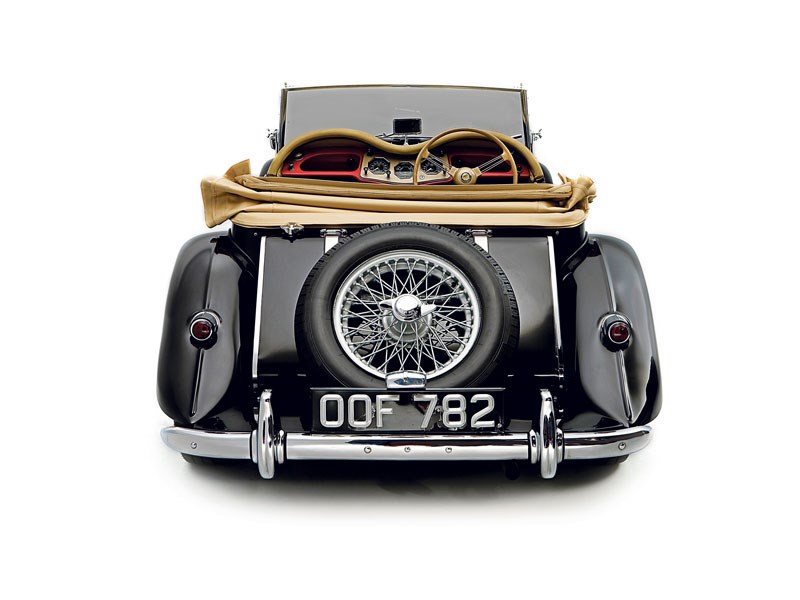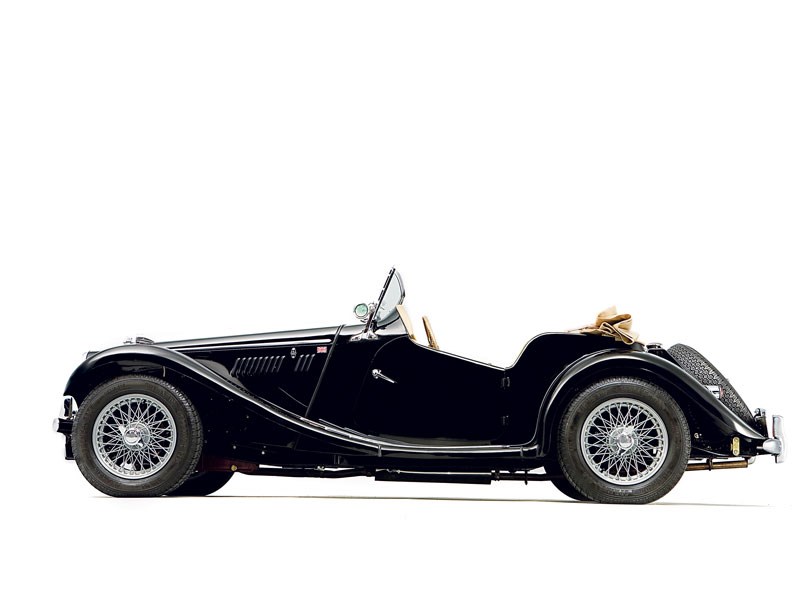The original MG TF simply oozes traditional British style and charm.
TFs have a vintage feel to match their sporting looks. That said, they do feel more civilised than their earlier T-series siblings, as well as benefiting from a slightly wider cockpit. They have better road manners, too – the ride isn’t as harsh and the rack-and-pinion steering is devoid of any play.
When the twisty bits arrive, the reworked front suspension comes into its own, with the steering remaining light and the nose responding immediately. It can be accelerated in a long, constant radius corner to the point where feeding in more power will simply push the nose further into the curve. The car feels sporty, urging you to be smooth and precise in order to extract the best from the rudimentary chassis. Even the brakes discourage you from scrubbing off speed.
Driving cautiously in an MG is sacrilege – slow corners should be taken in second gear, fast uphill bends should be rounded in third, with high speed curves allowing you to exploit the accurate steering. Only those who appreciate the sheer fun of driving a car will ever get to like the MG.
VITAL STATISTICS
MG TF1500
Engine 1466cc/4-cyl/OHV
Power (bhp@rpm) 65bhp@5500rpm
Torque (lb ft@rpm) 76lb ft@3000rpm
Top speed 85mph
0-60mph 16sec
Consumption 28mpg
WHAT TO LOOK FOR
BODYWORK & CHASSIS
Looking at the scuttle, severe corrosion can set in around the screen brackets. Also check at the bottom of the bulkhead, as the wing beading traps moisture. Corrosion around the edge of each wing is normal, while the seams between panels can also harbour rust. TAs, TBs and TCs have a partially-boxed and open channel chassis, while TDs and TFs have fully-boxed types that are made of thinner metal and actually have more rust traps. These are more likely to suffer from perforation on the undersides than the early models, so be sure to check them throroughly.
All T-series cars relied on wooden framing, although the TF utilised more metal than the earlier models for added rigidity. It’s the wood that causes the greatest problems, with most of it being hidden from view. There’s an exposed crossmember beneath the dash – if this is rotten, then chances are the rest of the woodwork is, too. TF’s are fitted with plywood floorboards – new ones are easy to make, but rusting fixing screws can make the old ones difficult to remove. Body mounting outriggers can rot away merrily, so they also need to be checked carefully.
ENGINE
Engines are seldom oil-tight, so expect seepage from the tappet cover and rocker box. Leaks from the front and rear of the crankshaft are also common, and a heavy leak from the latter will require removal of the engine to fully eradicate the problem. Engines should last between 60,000-80,000 miles, provided that good quality 20/50 lubricant has been used.
The 1250cc unit is a simple one, with shell bearings. However the crankshaft can break across the front web, while the valves can drop into the cylinders when their heads break off. Cam followers also wear quickly. Take the car for a test drive to fully warm it up – with the engine good and hot, oil pressure should be around 50lb/sq in at 40mph. Expect to hear valve gear chatter unless the engine has been freshly rebuilt. If noise is excessive, then suspect a worn rocker shaft and bushes, especially if oil pressure at tickover is down to 10lb/sq in or less. A heavier intermittent knock at half engine speed when the motor is revved suggests worn cam followers and camshaft.
RUNNING GEAR
TF gearboxes are notoriously weak, with the gears and layshaft oftenproving a problem. If a gearbox jumps out of gear or you hear significant whining, then a rebuild is the only cure, complete with a four-figure bill (cue more whining!).
There should be no play in the TF’s rack-and-pinion steering. They are durable, but rattles may be due to slackness in the adjustable inner balljoints on the tie-rods. Negative camber on the independent front suspension usually means that the swivel pins and links are badly worn. The phosphor bronze upper and lower trunnions are prone to wear – if they’ve been replaced by steel MGA items, then they’ll be even more worn. Regular lubrication with a mixture of oil and grease will help reduce the wear rate.
BRAKES
TFs have the same front brake cylinders as MO Morris Oxfords, Wolseley 4/44s and MG Y-type saloons. MGB suspension rubbers and bushes will also fit, while retro-fitting an MGB anti-roll bar will improve handling.
INTERIOR
TFs should have leather upholstery and vinyl door trims. Assemble the hood and sidescreens, looking for damaged or missing fittings. It’s all available, but some original parts are scarce and costly, so be aware of this. Likewise, check all the instrumentation and switchgear is present and correct, as again some parts are very expensive.
OUR VERDICT
It is unfortunate that because of the delay in announcing the MGA, the demise of the TF virtually passed unnoticed. The TF’s passing marked an end of an era at Abingdon – from 1929, when the first M-type Midgets and 18/80s were built in the converted leather-goods factory, up until 1955, every MG sports car followed the same formula. The new MGA was an entirely different machine.
Whether you go for a TF1250 or TF1500, you will have a car with irresistible looks and handling that make it fun to drive. Performance may not be earth-shattering, but the grin on your face will be significant regardless – if ever a car was built for simple pleasures then this
is it. The TF represents a carefree bygone age of motoring. Who’d have thought that of a car borne out of rationalisation and considered to be compromised from the outset?
By 1953, MG’s TD was facing serious challenges from the much more powerful Triumph TR2s and Austin-Healeys. Abingdon bosses knew something had to be done and the TF was the result. Boasting a semi-streamlined body, the new model retained the TD II’s engine and running gear, but swapped
in a higher ratio back axle.
Regarded as the prettiest of the T-types today, the TF actually received a mixed reception in period. It featured a steeply raked front grille, streamlined front wings and faired-in headlamps. The old-fashioned rear ‘slab tank’ and external spare wheel kept the traditional looks alive. Initially the car was launched with the faithful 1250cc XPAG engine that had made its debut in the TB Midget in 1939. Some enthusiasts were disappointed as they’d hoped for more power – the Triumph TR2 was capable of more than 100mph compared to the ‘flat out’ 80mph achievable in the TF. The XPAG engine was later bored out to 1466cc to improve performance. Total production reached 9600 between 1953-1955, of which about 3500 had the larger engine.


